2) "Soldier spearing fallen horseman" (mentioned on this page, mainly on the next page)
3) other post-reform imitations
Return to the main page on imitations.
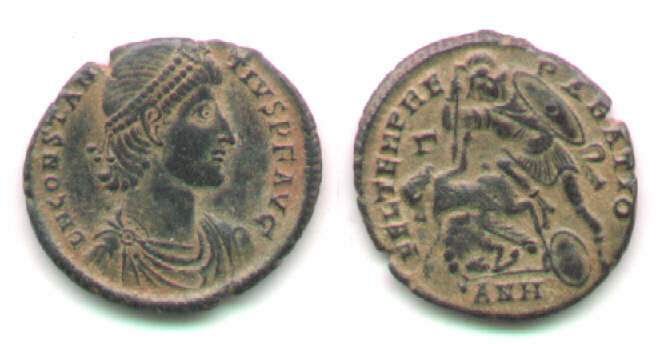
FEL TEMP REPARATIO imitations of
"Galley" and "Soldier spearing fallen horseman"
c. AD 348 - 356 and other post-reform imitations
1) "Galley" (this page)
2) "Soldier spearing fallen horseman" (mentioned on this page, mainly on the next page)
3) other post-reform imitations
Return to the main page on imitations.

The coin reform of c. 348 introduced a new AE denomination of about 23 mm diameter and surface-silvered so that the total silver content was a few percent. There were several types with the same reverse legend, FEL TEMP REPARATIO ("Happy times are here again"), but only two were commonly imitated.
In the east under Constantius II the type was "soldier spearing fallen horseman" with a large soldier looming over and about to spear a tiny (Persian) horseman who horse has fallen.
Prototype here at the right: RIC Antioch 132, extremely common. Gamma in field left, ANH mintmark. AE23. 11:00.
/Large solider lunging to spear small horseman who is leaning back to ward off the spear as his horse is tumbling over its head. The horseman has lost his shield (on the ground, right).
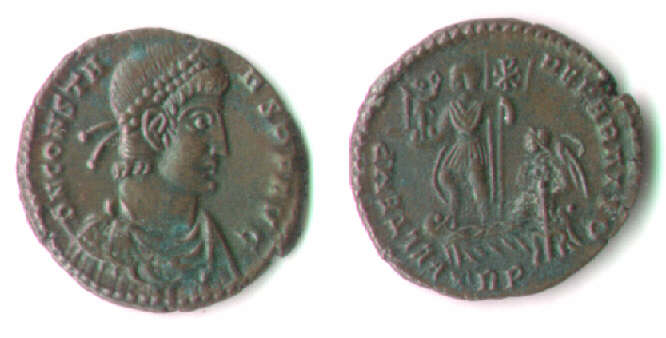
In the west the type was the "galley" under Constans, with the emperor standing left on a galley, holding Victory or phoenix and a labarum (with chi-rho), and Victory holding the rudder. Each co-ruler minted for the other, but fewer coins than for himself. In its original large AE2 size, "galley" is more common for Constans [by two to one in the huge Vienna collection], and "Solder spearing fallen horseman" is more common for Constantius II [also by two to one].
Prototype here: RIC Trier 219, extremely common. TRP mintmark. AE23. 6:00. 5.24 grams.
/Emperor holds Victory and labarum with chi-rho, Victory at rudder
Although there are other "FEL TEMP REPARATIO" types (including "phoenix," "hut," and "emperor and two captives"), only "galley" and "fallen horseman" were frequently imitated, and these only in the west -- particularly in Britain. When Constans was killed in the revolt of Magnentius in Gaul in 350, apparently the supply of coins to Britain dried up and the populace began making their own. Similarly, in Gaul, imitations of coins of Magnentius are very common -- as common as his official pieces. In Britain, the full-size AE2 imitations are probably more common than the official pieces. The "galley" type of Constans was discontinued at his death while it was still a large coin. Full-size AE2 "fallen horseman" imitations are hard to find and substantially outnumbered by full-size "galley" imitations. But both numbers are dwarfed by the numbers of small and even tiny "fallen horseman" imitations which are found by the thousands -- the smaller the more common. Even the official coins rapidly declined to AE3 size over the period 350-356. We can deduce that the large imitation AE2's were produced 348-350 alongside the large offical coins, and that the smaller copies followed later. [to be continued] There is reason to believe that they were discontinued about the time of Valentinian I (AD 364) because his new AE coins reached Britain in large numbers (undermining the shortage excuse for counterfeiting) and had no silver (undermining the profit motive). No one could have thought that tiny imitation "fallen horseman" 12 millimeter pieces were comparable to Valentinian's 18 millimeter AE3's. The tiny imitations must have been "emergency" currency for a monetised economy temporarily without a supply of official coins.
This page continues on about "galley" imitations.
Jump to the page emphasizing "fallen horseman" pieces.
Jump to the page with other post-reform imitations.
"Galley" imitations

AE22. 6:00. 6.40 grams
Constans
Well-engraved designs and mostly correct obverse letters and legend, but with incorrect reverse letters.
DN CONSTI - ..S PF AVG
/garbled reverse legend. If anything, possibly a retrograde attempt at FEL TEMP REPARATIO
/mintmark unclear, possibly incorporating an "S"
/X on standard, emperor holding phoenix (why are these usually "holding phoenix" instead of the common "holding Victory" variant?)
Reference: Imitation quite similar to Bastien, ANSMN 30 (1985) plate 42.27.

AE23-21. 9:00. 3.03 grams.
Constantius II
CONSTANT - IVS R AVG [sic] missing the "F" of "PF" and some letters ill-formed.
/FEL TEMP ERATIO [The first "R" of "REPARATIO" is missing]
/in exergue; mostly off flan.
Stylistically this piece is similar to the previous coin.
In spite of the fact there are numerous full-sixed "galley" imitations on this page, I think they are scarce to rare. I think they are essentially found only in Britain. The Ashmolean Museum at Oxford does not have many, and auction catalogs rarely have them, although nice ones would be worth selling at auction. If you are from Britain (or Gaul) and know that they are more common than I think, please write and correct me at  .
.
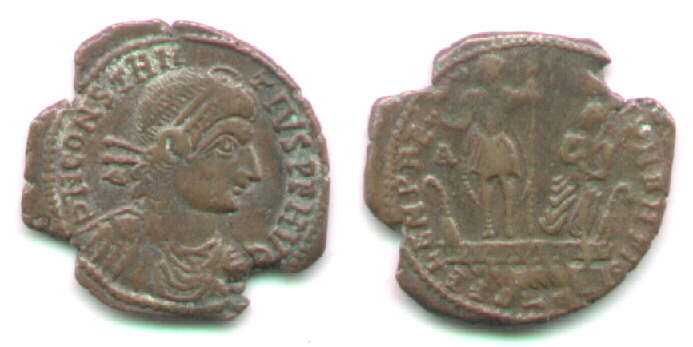
Ragged AE25. 6:00. 5.39 grams
Constantius II
An example so good it is not immediately obvious it is not official. However, it does look slightly irregular and the error in the reverse legend seals the matter.
DN CONSTAN-TIVS PF AVG
/FEL EMP RE-PARTIO [sic -- the "T" of TEMP is missing. Note the "FEL" begins almost directly below the galley], "A" in field left
/the mintmark is not strong, but looks like "SLO" which may be intended as "SLG" from Lugdunum.
Prototype: RIC Lyons 100 "second series, 348-350" has the "A" in the left field and SLG mintmark.
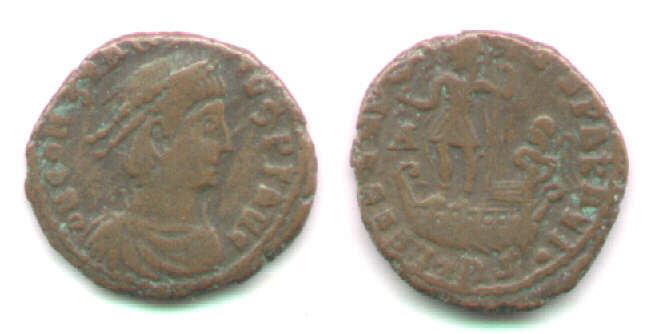
AE23. 10:30. 6.17 grams.
Constantius II, prototype minted at Trier, 348-350.
Again, the galley type has the phoenix in the emperor's right hand. There is an extremely similar type with a Victory, but it does not seem to have been imitated (at all?)
Another example so good, and heavy, it is not obvious it is not official. But, the signs are there. The lettering is uneven. On the reverse the "FEL TEMP" is poorly done, and the second R of "REPARATIO" is like a B, and the O a dot. But the clincher is the combination of obverse and reverse details. Note the "A" in the left field of the reverse. Official types have either A's on both sides (which would be behind the head on the obverse) or A's on neither side. This mule has the earlier obverse (no A) and the later reverse, mixing RIC VIII Trier 214 with 239.
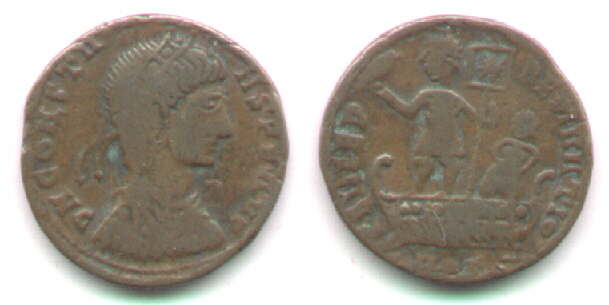
AE22. 1:30. 5.75 grams
Constans
Good obverse legend letters, but less attempt at correctness on the reverse.
It is quite evenly worn.
DN CONSTA-NS PF AVG, correctly
/legend resembles FEL TEP REPARATIO [with no "M" in TEMP]
/mintmark long, but too weak to identify
Prototype: Possibly RIC Aquileia 94-96 (23-24 mm) rosettes as on 109A (18-19 mm) which is half the weight. 94-96 are on a standard of 5.20 grams, less than this!
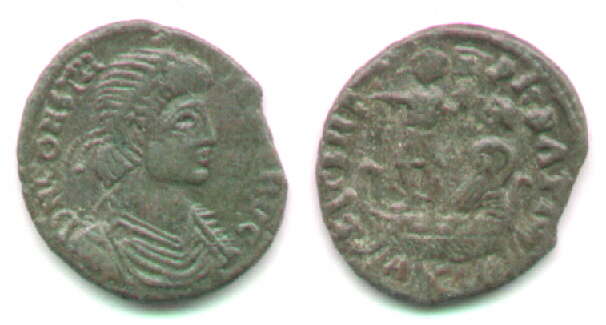
AE23-20. 4.95 grams.
Constans
DN CONSTA-NS PF AVG, legible letters on obverse
/illegible letter-like forms, possibly resembling "AQP" in exergue (for Aquileia mint)
Sear 3973 prototype. RIC Aquileia 99. "348- 19 Jan. 350". Page 323.

Thick AE21-19. 1:30. 7.21 grams.
Constantius II
Boldly struck with dies too large for the flan, which is distinctly thicker and heavier than the flans of official pieces.
obverse legend partly off the flan, but enough remains to suggest it was imitating
DN CONSTAN-TIVS PF AVG, "A" behind head
/Even less of the reverse legend remains, and the letter-forms are worse. Nevertheless, it clearly attempted
/FEL T[EMP REPAR]ATIO
/the mintmark might be nonsense, or it might be "CON" retrograde.
Reference: Possibly this combines RIC Arles 125 (which has the "A" behind the head but "A" in reverse field and PARL mintmark, with the "PCON" mintmark of the period after Magnentius, 353-355.

AE23-22. 6:00. 4.63 grams.
Constantius II
Fine style with even green patina. All letters legible, but of slightly uneven sizes.
/in exergue: TRS
The portrait is slightly exaggerated comapred to that of official issues. Victory is more animated. This is an outstanding example of the counterfeiter's arrt.
Prototype: TIC Trier 214, page 153, plate 2.214.

AE23-22. 6:30. 3.98 grams.
Constans
Dark green English patina. Fine lettering.
DN CONSTANS PF AVG, note the ear is too high.
/chi-rho on standard, in exergue: PLC
Prototype: RIC Lugdunum 71, page 182 "348-350" first series of two.

AE23-21. 5:00.
Constans
Lettering complete, but less well formed. Obverse weak strike.
/in exergue: RS [?]
Prototype: RIC Rome 109-111, page 256.
Most galley imitations imitate coins from more westerly mints.
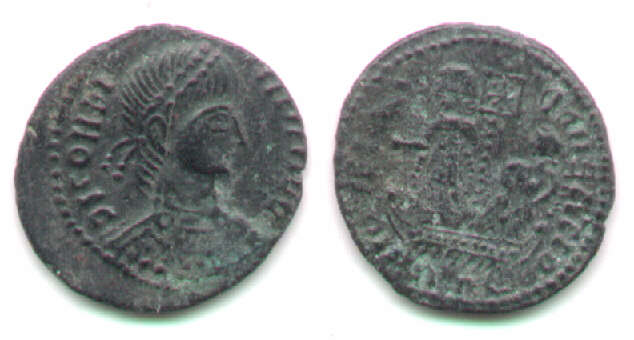
AE24-22. 6:00.
Constans (probably)
Black patina. Very crude lettering, not close to official. The hair and wreath are bold.
The obverse begins with an attempt at "DN CON..." but degenerates.
/the reverse legend ends "TIO" properly, but the other letters are only approximate.
/ in exergue: I's, not clear.

AE24. 6:00. 6.08 grams.
Constans (probably)
Weak strike, double struck at chin. Lettering on the obverse left is bold, but illiterate. It does not appear to have as many letters as Constantius II coins of this type, so it is probably an imitation of a Constans.
Reverse mintmark appears to be PLG, with indications of the legend at the end resembling REPARATIO.
Overall, very poorly done, but full size and weight.
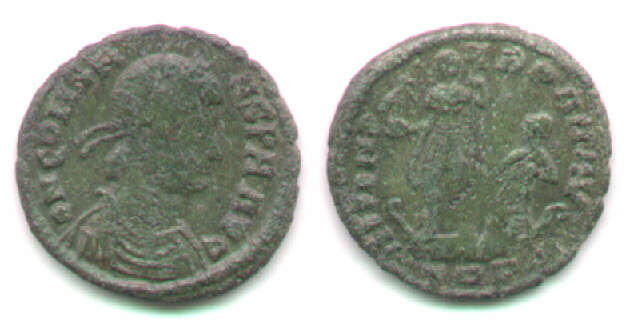
AE22. 6:00. 4.38 grams.
Constans
Almost correct obverse legend: DN CONSN NS PRAVG [with geneous interpretation of some ill-formed letters]
/[FEL TE]NP RPA..AV
/in exergue: T..P
As is common, the obverse legend is closer to correct than the reverse.
Prototype: RIC VIII: Trier 215, listed as "rare" but very common with victory instead of phoenix. Page 153.
Question: What is the monetary difference between the nearly identical galley types issued with emperor holding Victory and those where he holds a phoenix? Why do these galley types imitate the phoenix type in preference to the Victory type?
If you have any ideas, e-mail me at 

AE22. 7:00. 5.04 grams.
Constantius II
The lettering is rather good, although not quite right on the reverse.
/the "FE" of "FEL" begins below the prow of the galley.
/in exergue: <dot>SLC
Prototype: RIC Lyons 73, p. 182, "S".
AE22-19. 6:00. 4.42 grams.
Constantius II
Obverse lettering gets large at the end.
/....PREDARA....in ill-formed letters
/mint mark not legible
The galley type and its imitations declined in size over time. Here are two official coins to the same scale, one AE23 and early, the other AE19. RIC suggests that these two sizes with the same design were issued simultaneously.

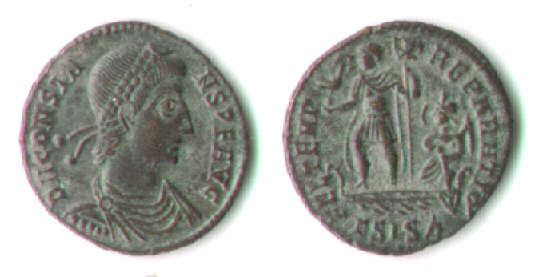
The large prototype, identifed above, weighs 5.24 grams. The small one, RIC Siscia 241, 1:00, weighs 2.66 grams.
Does this mean that small "galley" imitations are imitations of the so-called half-denomination, or simply slightly later imitations from when the sizes of coins had declined?
I think small imitations are not imitations of the half denomination, rather later in time, after the full-size oficial coins were no longer issued.
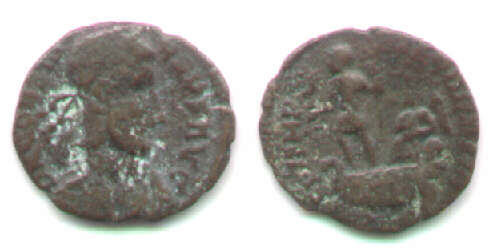
AE17. 12:00. 1.55 grams.
Constans
Weakly struck, but legible, and close to official style.
DN CONSTA - NS PF AVG
/FEL TEMP [RE]PARATIO, emp on galley left, holding phoenix, Victory at helm
The 16-18 mm prototype has a weight standard of 2.42 grams (RIC Trier 238, Lyon 96, plate 4, Arles 117)
Continue with the page on "fallen horseman" imitations.
Return to the main page on imitations.